
Acanthomorpha is an extraordinarily diverse taxon of teleost fishes with spiny fin rays. The clade contains about one-third of the world's modern species of vertebrates: over 14,000 species.
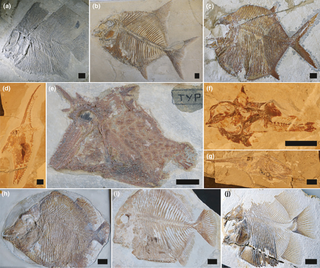
Pycnodontiformes is an extinct order of primarily marine bony fish. The group first appeared during the Late Triassic and disappeared during the Eocene. The group has been found in rock formations in Africa, Asia, Europe, North and South America. They were small to middle-sized fish, generally with laterally-compressed deep bodies, some with almost circular outlines, adapted for manuverability in reef-like environments, though the group was morphologically diverse. Most, but not all members of the groups had jaws with round and flattened teeth, well adapted to crush food items (durophagy), such as echinoderms, crustaceans and molluscs. Some pyncodontiformes developed piranha like teeth used for eating flesh. Most species inhabited shallow marine reef environments, while a handful of species lived in freshwater or brackish conditions. While rare during the Triassic and Early-Middle Jurassic, Pycnodontiformes became abundant and diverse during the Late Jurassic, exhibiting a high but relatively static diversity during the Early Cretaceous. At the beginning of the Late Cretaceous they reached their apex of morphological and species diversity, after which they began to gradually decline, with a more sudden decline at the end of the Cretaceous due to the collapse of reef ecosystems, finally becoming extinct during the Eocene. They are considered to belong to the Neopterygii, but their relationship to other members of that group is uncertain.

Trewavasia carinata is an extinct pycnodontid fish in the family Coccodontidae that lived during the lower Cenomanian of what is now Lebanon. It had a large, forward-pointing horn-like spine between its eyes, and a massive stump-like spine emanating from the back of its head. T. carinata is closely related the genera Corusichthys and Hensodon, as well as Coccodus.
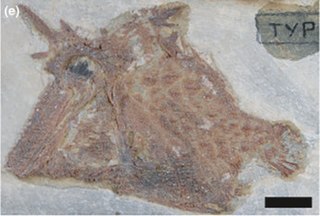
Ichthyoceros spinosus is an extinct pycnodontid that lived during the lower Cenomanian of what is now Lebanon. I. spinosus had a triple, forward-pointing horn-like spine between its eyes, very similar to the single spine of Trewavasia, and a massive, multipointed spine emanating from the back of its head. It was originally placed in the family Coccodontidae, but then was transferred to "Trewavasiidae" with Trewavasia. Recently, it has been placed in Gladiopycnodontidae due to recent anatomical similarities with the various genera within that family, including Gladiopycnodus.
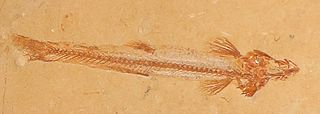
Charitopsis is an extinct genus of prehistoric marine ray-finned fish that lived during the lower Cenomanian. It was a relative of modern beaked salmons. It contains a single species, C. spinosus from the Sannine Formation of Lebanon. It is possibly related to the sympatric gonorynchid Charitosomus, although some anatomical traits are more similar to the Cenozoic gonorynchids.

Aphanepygus is an extinct genus of prehistoric marine holostean ray-finned fish that lived during the upper Cenomanian. It inhabited the former Tethys Ocean, with remains known from Lebanon and Croatia. Its exact affinities are uncertain, although it is usually recovered as a relative of the macrosemiids. However, other authorities recover it in the Ionoscopiformes.
Spathiurus is an extinct genus of prehistoric ray-finned fish that lived during the Cenomanian in the Sannine Formation of Lebanon.
Telepholis is an extinct genus of prehistoric bony fish that lived from the Cenomanian to Campanian.
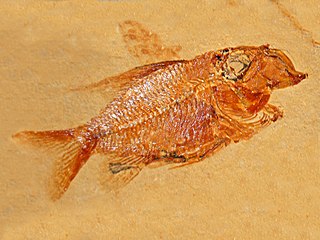
Lissoberyx is an extinct genus of prehistoric ray-finned fish belongon to the family Trachichthyidae. Lissoberyx is a trachichthyid, but it shows more resemblance to the holocentrids than any other trachichthyid.
Carsothrissops is an extinct genus of prehistoric marine ray-finned fish that lived during the Cenomanian. It contains a single species, C. delorenzi from Komen, Slovenia.
Casierius is an extinct genus of marine ray-finned fish that lived during the Albian stage of the Early Cretaceous epoch. It was a relative of the modern bonefish in the extinct family Phyllodontidae, although some authorities consider it either a true albulid or a very early eel. It contains a single species, C. heckeli, known from the Glen Rose Formation near Hood County, Texas.
Anomoeodus is an extinct genus of prehistoric marine ray-finned fish belonging to the family Pycnodontidae. This genus lived during the Late Cretaceous period, ranging from the Albian to Maastrichtian ages, and had a wide geographic distribution, with fossils found in France, Belgium, the Netherlands, Spain, Egypt, Uzbekistan, and the United States. Some studies have recovered it as a wastebasket taxon. The first fossils of Anomoeodus were described by Louis Agassiz in 1833, although they were described under Pycnodus.
Athrodon is an extinct genus of marine pycnodontid fish that lived in shallow seas in what is now England, Germany, Spain and France from the Late Jurassic until the genus' extinction during the start of the late Cretaceous. The various species are very similar in splenial bone and tooth morphology to Mesodon. Otherwise, no articulated or complete specimen is known: all fossil specimens are bone fragments and disarticulated teeth. This genus is thought to be diagnosed by the presence of four lateral tooth rows. The presence of this genusin the Cretaceous is disputed, as the remains of Cretaceous species could belong to other genera.
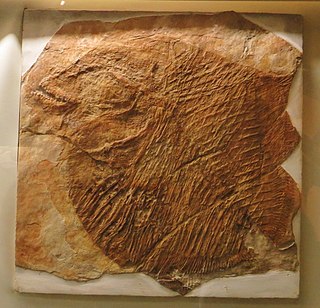
Coelodus is an extinct genus of marine and possibly freshwater pycnodont fish. It contains only one definitive species, C. saturnusHeckel, 1854, from the Late Cretaceous of Slovenia. Other species from the Late Jurassic to the Eocene have also been attributed to this genus based on isolated dental elements, but their assignment to Coelodus is uncertain, and this genus likely represents a non-monophyletic wastebasket taxon. A potential diagnostic trait is a prearticular tooth row with three regular highly elongated teeth.

Coccodontidae is a family of extinct pycnodontid fish that lived during the lower Cenomanian. The various genera had massive, curved spines.

Hensodon spinosus is an extinct pycnodontid that lived during the Upper Cenomanian of what is now Lebanon. H. spinosus superficially resembled a marine angelfish with a massive head, and a very spiny pectoral girdle. Different specimens have different arrangements of the horn-like frontal spines. One form has the horns arranged as a double-prong, assumed to be the male, and the other form, assumed to be the female, having the horns one after the other, like those of a rhinoceros.
The Sannine Formation, also called the Sannine Limestone, is a Cretaceous geologic formation in Lebanon.

Corusichthys megacephalus is an extinct pycnodontid that lived during the lower Cenomanian of what is now Lebanon. C. megacephalus is known from a 34 mm long fossil. It had plates arranged like a helmet around its head, and had a massive, triangular spine on its dorsal side. C. megacephalus is closely related the genera Trewavasia and Hensodon, as well as Coccodus.
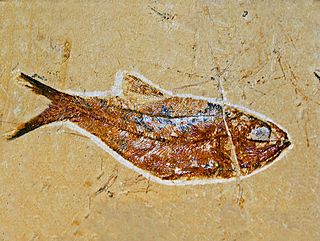
Armigatus is an extinct genus of marine clupeomorph fishes belonging to the order Ellimmichthyiformes. These fishes lived in the Cretaceous ; their fossil remains have been found in Mexico, southern Europe, the Middle East and North Africa, suggesting the genus ranged across the Tethys Sea.
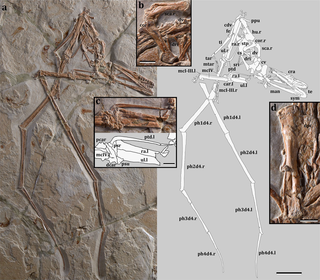
Mimodactylus is a genus of istiodactyliform pterosaur that lived in what is now Lebanon during the Late Cretaceous, 95 million years ago. The only known specimen was discovered in a limestone quarry near the town of Hjoula, belonging to the Sannine Formation. The owner of the quarry allowed the specimen to be prepared and scientifically described by an international team of researchers, and when it was eventually sold, the buyer donated it to the MIM Museum in Beirut. In 2019, the researchers named the new genus and species Mimodactylus libanensis; the generic name refers to the MIM Museum, combined with the Greek word daktylos for "digit", and the specific name refers to Lebanon. The well-preserved holotype specimen is the first complete pterosaur from the Afro-Arabian continent, and the third pterosaur fossil known from Lebanon.














